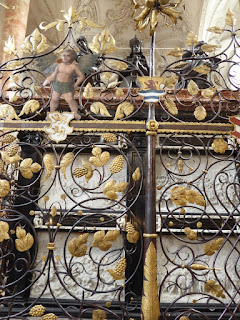 |
| Maximilian I Cenotaph |
Besides the Tyrol Panorama (see Tirol Panorama), the Hofkirche was another destination to visit on my "Things to do in Innsbruck" list. The Hofkirche was built as a memorial to Maximilian I by his grandson, Ferdinand I in 1553.
 |
| Hofkirche |
 |
| Hofkirche |
 |
| Ornate iron grille work |
 |
| Capture of Kufstein Fortress, 1504 |
 |
| Victory over Bavarians at Regensburg, 1504 |
 |
| Capture of Fortress of Murano, 1514 |
 |
| Battle relief in which I did not capture the caption |
Several of the statues that I could identify are:
 |
| Ernest, Duke of Austria |
 |
| Ferdinand I |
 |
| King Arthur |
 |
| Phillip I |
 |
| Rudolph I |
 |
| Theoderic the Great |
 |
| Tomb of Andreas Hofer |
Lovely sculptures and reliefs!
ReplyDeleteI've only really passed through Austria,Im sure it's worth a visit!
Best Iain
Innsbruck is definitely worthy of a visit. My wife and I enjoyed it more than expected. The mountain scenery is spectacular.
DeleteIf we won the lottery we would live in Austria as it's such a beautiful country. One can but dream...
ReplyDeleteYou are not alone in that dream. We loved Switzerland too.
Deletei will have to keep this in mind! Thanks for sharing it.
ReplyDeleteWith the Tirol panorama on the 1809 revolt and the Renaissance ties with Maximilian I, two of your favorite periods could be studied. Oh, include the Kaiserjager Museum and you could hit the trifecta!
DeleteYes, that would be on the agenda, too! Next door to the cyclorama, I think,
DeleteRighto! The cyclorama and museum are connected by underground passageway.
DeleteSuch fine work and 500 years old?
ReplyDeleteYes, nearly 500 years old and looking fabulous.
DeleteLooks excellent! I need to get down there sometime and see for myself.
ReplyDeleteChristopher
World Road Cycling Championships are in Innsbruck next weekend, perfect time for a visit, Christopher.
DeleteReminds me of my time in Bavaria and Catholic Germany that close to Austria: even small towns have exquisite churches, each one a museum. Thanks for sharing!
ReplyDeleteSpot on, Ed! Every CCA is a museum. The Hofkirche actually has a museum adjoining it including a media presentation on Maximilian.
DeleteImpressive statues, I went to Innsbruck many years ago and I'm keeping a very good memory of it, nice post!
ReplyDeleteHappy to rekindle good memories for you.
DeleteThese posts of yours could give a person the travel bug, Jonathan!
ReplyDeleteI hope so!
DeleteThanks for posting Jonathan. It brings back many memories from 30 years ago. I must get back to Innsbruck again and maybe Vienna.
ReplyDeleteGlad you enjoyed the visit to Hofkirche!
DeleteExcellent travel. Thank You for a photos
ReplyDeleteYou are welcome!
DeleteVery neat, Jonathan. Dig the statues in armor.
ReplyDeleteDean, I thought of you posing in your full armor while I was admiring these rows of bronze statues.
DeleteRemarkably well maintained reliefs and statues for being a "mere" 500 years old. Wow. Such detail as well.
ReplyDeleteYes, the works are a "mere" 500 years old. The church is really a museum with the focus om Maximilian. The reliefs are amazingly detailed.
DeleteExcellent stuff. Any inspiration to tackle more Renaissance figures?
ReplyDeleteThanks! Such a silly question...
Delete